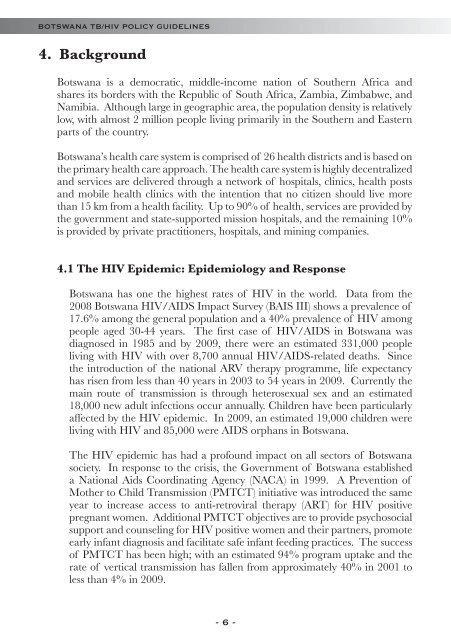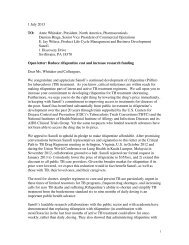BOTSWANA TB/HIV POLICY GUIDELINES - TB Online
BOTSWANA TB/HIV POLICY GUIDELINES - TB Online
BOTSWANA TB/HIV POLICY GUIDELINES - TB Online
Create successful ePaper yourself
Turn your PDF publications into a flip-book with our unique Google optimized e-Paper software.
<strong>BOTSWANA</strong> <strong>TB</strong>/<strong>HIV</strong> <strong>POLICY</strong> <strong>GUIDELINES</strong><br />
4. Background<br />
Botswana is a democratic, middle-income nation of Southern Africa and<br />
shares its borders with the Republic of South Africa, Zambia, Zimbabwe, and<br />
Namibia. Although large in geographic area, the population density is relatively<br />
low, with almost 2 million people living primarily in the Southern and Eastern<br />
parts of the country.<br />
Botswana’s health care system is comprised of 26 health districts and is based on<br />
the primary health care approach. The health care system is highly decentralized<br />
and services are delivered through a network of hospitals, clinics, health posts<br />
and mobile health clinics with the intention that no citizen should live more<br />
than 15 km from a health facility. Up to 90% of health, services are provided by<br />
the government and state-supported mission hospitals, and the remaining 10%<br />
is provided by private practitioners, hospitals, and mining companies.<br />
4.1 The <strong>HIV</strong> Epidemic: Epidemiology and Response<br />
Botswana has one the highest rates of <strong>HIV</strong> in the world. Data from the<br />
2008 Botswana <strong>HIV</strong>/AIDS Impact Survey (BAIS III) shows a prevalence of<br />
17.6% among the general population and a 40% prevalence of <strong>HIV</strong> among<br />
people aged 30-44 years. The first case of <strong>HIV</strong>/AIDS in Botswana was<br />
diagnosed in 1985 and by 2009, there were an estimated 331,000 people<br />
living with <strong>HIV</strong> with over 8,700 annual <strong>HIV</strong>/AIDS-related deaths. Since<br />
the introduction of the national ARV therapy programme, life expectancy<br />
has risen from less than 40 years in 2003 to 54 years in 2009. Currently the<br />
main route of transmission is through heterosexual sex and an estimated<br />
18,000 new adult infections occur annually. Children have been particularly<br />
affected by the <strong>HIV</strong> epidemic. In 2009, an estimated 19,000 children were<br />
living with <strong>HIV</strong> and 85,000 were AIDS orphans in Botswana.<br />
The <strong>HIV</strong> epidemic has had a profound impact on all sectors of Botswana<br />
society. In response to the crisis, the Government of Botswana established<br />
a National Aids Coordinating Agency (NACA) in 1999. A Prevention of<br />
Mother to Child Transmission (PMTCT) initiative was introduced the same<br />
year to increase access to anti-retroviral therapy (ART) for <strong>HIV</strong> positive<br />
pregnant women. Additional PMTCT objectives are to provide psychosocial<br />
support and counseling for <strong>HIV</strong> positive women and their partners, promote<br />
early infant diagnosis and facilitate safe infant feeding practices. The success<br />
of PMTCT has been high; with an estimated 94% program uptake and the<br />
rate of vertical transmission has fallen from approximately 40% in 2001 to<br />
less than 4% in 2009.<br />
- 6 -






